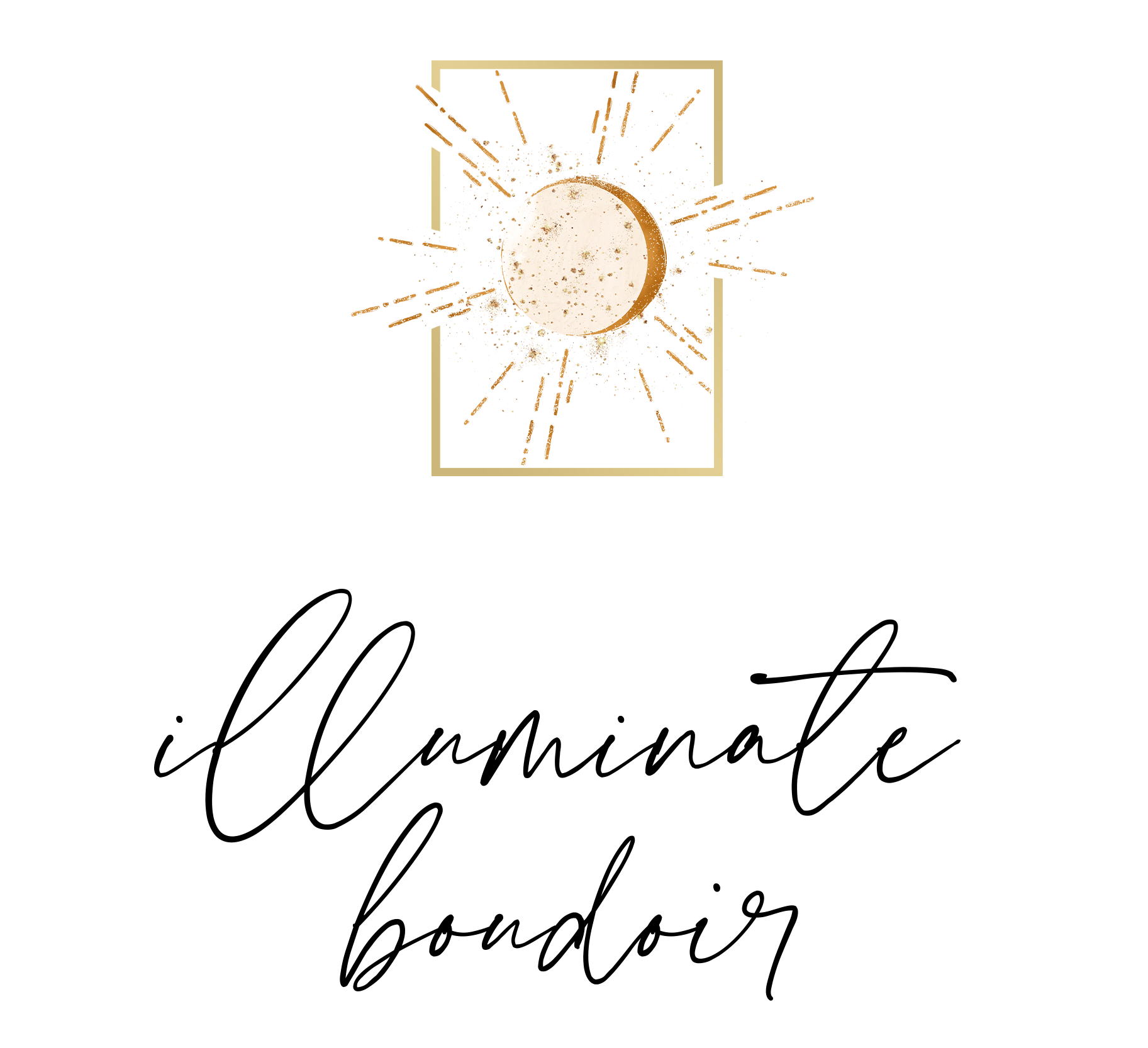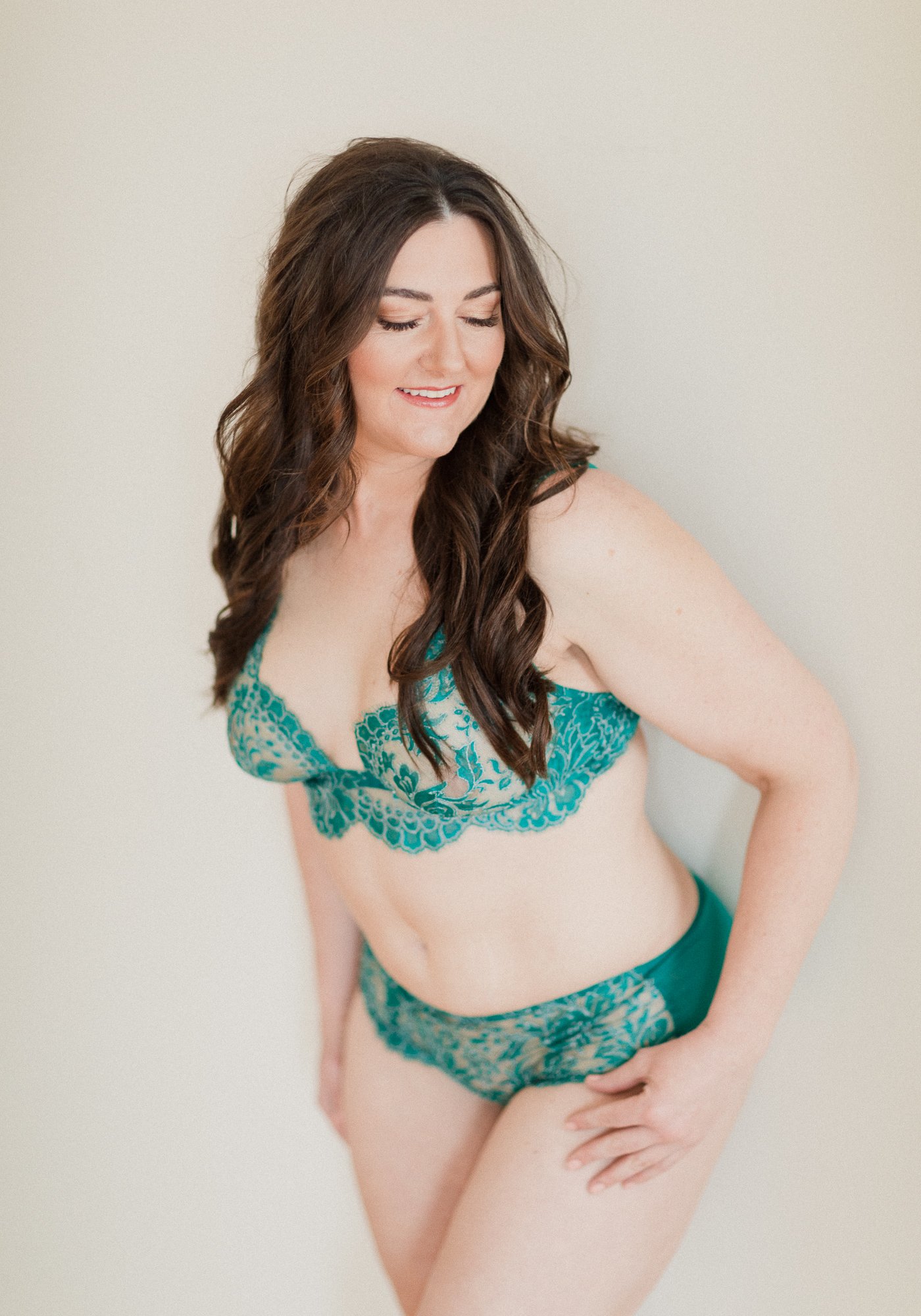Top 5 outfit tips: Planning your boudoir wardrobe
Feeling stuck thinking about what to wear for a boudoir session? You are not alone! Wardrobe questions are among the most frequently asked questions I hear from clients. The vast majority of us aren’t used to dressing for photoshoots, especially in our underwear, so it makes sense to wonder: where do I begin?
Based on the hundreds of planning conversations and sessions I’ve had with clients, I’ve compiled my top 5 tips when it comes to creating your boudoir wardrobe.
Wardrobe planning tips:
Tip #1: Avoid “shoulds” in all things boudoir (as in life!).
So many of my clients tell me they feel like they “should” wear a certain style of clothing during their boudoir session–like a matching bra and underwear set or lacy lingerie– but they don’t actually want to. Beneath this “should” is the misconception that something is or is not right for boudoir. The truth is, boudoir in my studio is all about you, so you get to decide what feels right to you! Our culture has so many (mostly unhelpful) things to say about what we should wear, look like, act like, etc., and it can be exhausting to wade through all those expectations. On your boudoir day, I want you to be able to set all those shoulds aside and make space for you.
My biggest advice is that you wear something that looks and feels like you. Wear something that makes you say, “Wow, I love how I feel in this!” The confidence and comfortability that comes from wearing something you love will shine through beautifully in your portraits.
Tip #2: Consider the full range of wardrobe options available in boudoir.
Another big misconception about boudoir is that it has to include lingerie or nudity, but this just isn’t true! Any outfit – concealing or revealing – counts as boudoir, because boudoir in my studio is all about celebrating and documenting the authentic you. During your photoshoot, you’ll have time to wear 3-5 looks or outfits, so consider all the variations of clothing and layers you might want to wear, as well as how much skin you want to show.
I recommend asking: what kinds of clothing do you want to wear? Do you want to wear everyday clothing, like a favorite dress, blouse, or pair of jeans? Or would you prefer wearing lingerie you love, like a favorite bra and underwear set (matching or not!), corset, bodysuit, or teddy? Do you want to wear nothing and incorporate a fine art nude look, or an implied nude look wrapped up in a sheet, into your session (those are both super common and can count as a 'look' too!)? Do you want to include nightwear you feel radiant in– like soft pjs, a silk slip, or a flowy nightie? Do you want to pair any of these pieces together (think jeans on bottom with a bralette on top, cotton underwear with a cozy t-shirt, or wrapping a textured blanket around yourself over lingerie or nothing at all)? You can bring layers with you or use the options I have available in my studio layering wardrobe for clients, including breezy button-downs, lacy robes, and knit sweaters.
I understand all these options can feel exciting, and overwhelming, and if you're unsure I always let clients know that they can bring many wardrobe options with them on their photoshoot day. I’ll set aside time at the beginning of the session for us to lay out your options and talk through them together, and I'm happy to give guidance and suggestions. You can also download my wardrobe style guide to get more ideas about the range of outfit options you can wear and pair!
She wore everyday clothing for this look!
“A” wore a lightweight robe for this ethereal look.
This client mixed a bralette with a high-waisted pair of jeans.
“M” opted for an implied nude look wrapped up in a sheet.
Tip #3: Consider what colors you do, or do not, want to wear.
A common question I hear from clients is: what colors should I wear, or avoid, for my boudoir session? There truly is no one-size fits all answer to that question, so my response is to ask: which colors do you like to wear? I generally recommend folks avoid neon colors, like highlighter pink or electric yellow, because these colors can pale in photographs (although there have absolutely been exceptions where clients have rocked the neon look!).
Thinking about what mood you want to set for your boudoir session can be a helpful starting place to decide your color choices. To many folks, jewel tones like rich teal, plum purple or emerald tend to feel more dramatic, and soft colors like blush, cream, or heather gray tend to feel more romantic and easygoing.
But of course, all of this is subjective, and what matters is how these colors feel for you! Ask yourself: what colors feel strong to me? What colors feel dramatic, romantic, or soft to me? Consider the energy or feeling you want to bring into your session, and choose colors that give you that feeling. You can take my style quiz online to explore ideas for your boudoir style too!
And if you're totally unsure about colors, a formula I love to recommend is bringing in one outfit in a lighter color, one look in a darker color, and one outfit with a bold pop of color.
Soft colors:
dark colors:
Pops of color:
Tip #4: Strappy lines draw attention.
Without going into a full art theory lesson, it can be helpful to know that straight lines tend to catch the eye’s attention more than curved lines. Straight lines on an outfit will create emphasis and draw your gaze, while curved lines create more softness as they follow the natural curves on your body. This is important for boudoir wardrobe planning because it can help you consider which parts of your body you want to bring attention to during your photoshoot.
A lot of boudoir outfits involve straps - from dresses with subtle spaghetti straps (which will draw attention to your collarbones and shoulders) to bras or underwear with strappy details for drama. Anytime you're choosing a piece of clothing or underwear with a strap that creates a straight line, consider that part of your body – if it's a favorite area that you'd love to draw attention to, amazing! Rock it. Or, if the strap is fun but you realize that it's not an area you want to make a focal point in your portraits, you could choose a different wardrobe piece with curved lines or more solid fabric in that area.
The strappy detail on the neckline of this bodysuit brings attention to her collarbones and cleavage.
A more delicate example of a strap - the spaghetti strap on her bustier brings attention to her collarbone.
This lingerie set has so many strappy elements on the back - it’s all lines! The lines converge at her midback, so that really becomes a focal point here.
These underwear have a thick strap along the hip and under her booty - she loved how it highlighted the shape of her butt and brought attention to her legs in other photos.
Tip #5: Look at the outline each clothing item makes on your body, to analyze fit and how it will photograph!
One of my biggest tips for boudoir shopping (and for any clothing shopping really!) is to look at the outline on your body an article of clothing creates. As I mentioned in tip #4, straight lines and curved lines will emphasize different parts of your body. Notice which parts of your body an outfit line accentuates or softens, and ask yourself if that is what you were intending with that piece.
For example, let’s say you are choosing between two pairs of underwear: one is a solid-colored short made of cotton and the other is a cheeky bikini style made of lace. The outlines of these two will be really different!
Let’s compare the outlines of these two pairs of underwear:
Look at the outline of these solid cotton shorts - a lot of straight lines! The waistband is quite a straight line along her waist, and straight lines along her thighs.
Look at the outline of these cheeky lace underwear - no straight lines to be found here. The lace fabric has a scalloped edge, and the cheeky style has a curved line along her booty and low back.
The shorts will create a lot of straight lines on your body–across your waistband and on each thigh. Straight lines tend to draw attention and exude a strong, bold feeling. This outline could work great for folks who love their stomach and thighs or want their portraits to feel a little strong or sporty.
In comparison, the cheeky lace bikini underwear will create a lot of curved lines across your waist and butt. Curvy lines tend to highlight the body’s natural curves and create a softer, feminine feeling. This underwear style could work well for someone who wants to emphasize the curves of their body, avoid having a focal point on their belly, or bring a feminine feeling into their portraits.
Finally, an important thing to remember: there’s not a ‘good’ and ‘bad’ example here. These underwear are both awesome and these clients loved these two outfits! By comparing these, we can see that these two underwear styles fit really differently, and the straight or curved lines emphasize different feelings/moods, and highlight different parts of the body. As you choose outfits for yourself, look at the outlines on your own body - think about choosing straight lines where you want to draw attention, softer curving lines where you want avoid a focal point or to bring out a curvy/feminine feeling, and how either one can be great depending on the mood or vibe you want!

















